Analyzing Health and Social Care Management: Roles, Quality & Project
VerifiedAdded on 2023/06/10
|12
|3836
|301
Essay
AI Summary
This essay delves into the multifaceted aspects of health and social care management, examining the roles of managers in fulfilling patient needs and optimizing resource utilization within healthcare organizations. It emphasizes the importance of SMART objectives in driving continuous service improvement, reducing medical errors, and enhancing patient care. The essay further discusses the composition of healthcare management teams and their responsibilities in decision-making, financial oversight, and information management. It highlights the significance of training and development programs for healthcare employees, focusing on skills enhancement and confidence-building to ensure the delivery of safe and high-quality services. Performance management strategies for healthcare staff are explored, emphasizing the role of managers in monitoring, guiding, and motivating employees to improve their performance. The essay also addresses the critical role of quality in healthcare, emphasizing adherence to standards such as CQC, TQM, and NICE, and the importance of project planning in service delivery, covering situational analysis, priority setting, option appraisal, project budgeting, implementation, and monitoring to achieve intended results.
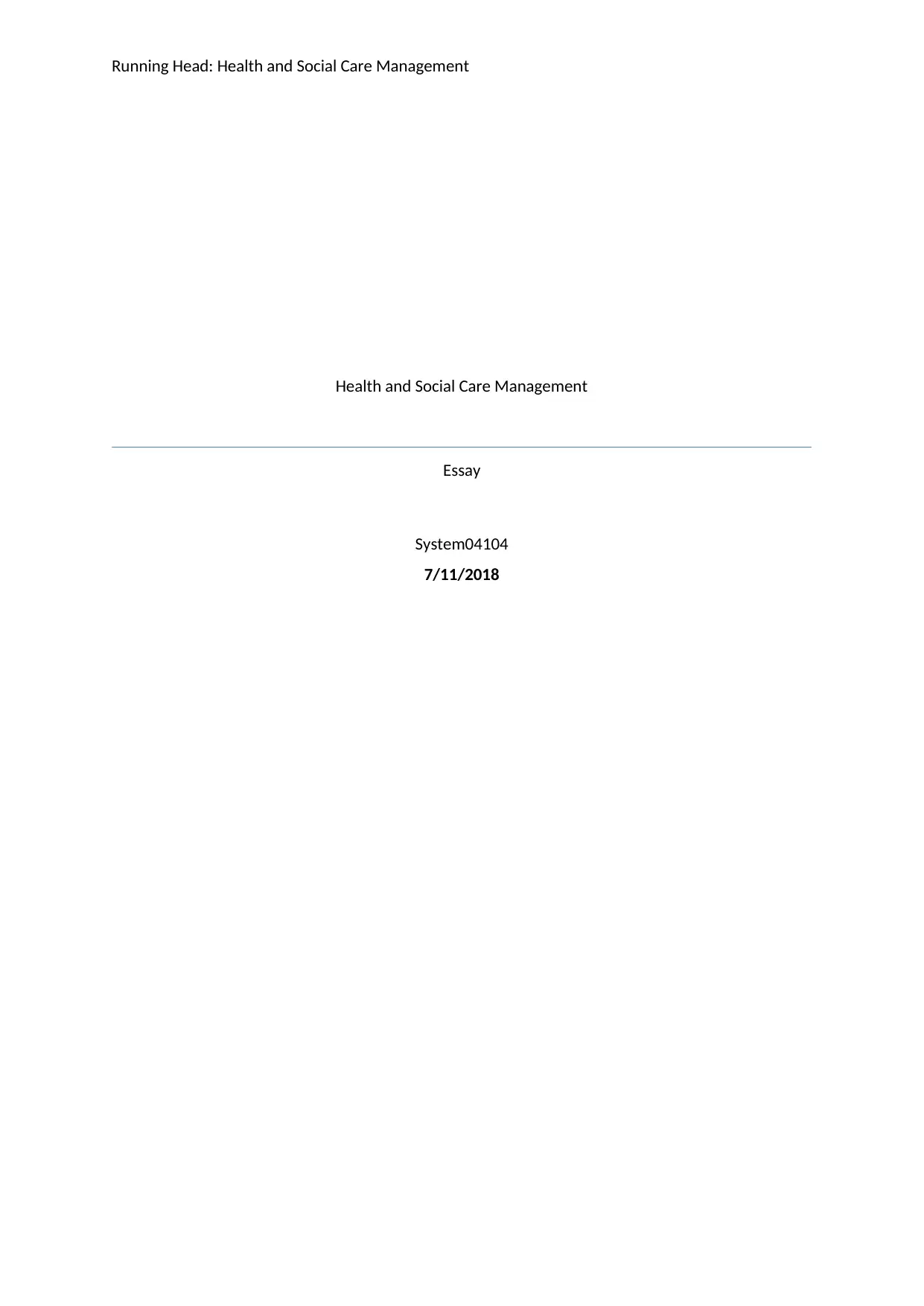
Running Head: Health and Social Care Management
Health and Social Care Management
Essay
System04104
7/11/2018
Health and Social Care Management
Essay
System04104
7/11/2018
Paraphrase This Document
Need a fresh take? Get an instant paraphrase of this document with our AI Paraphraser
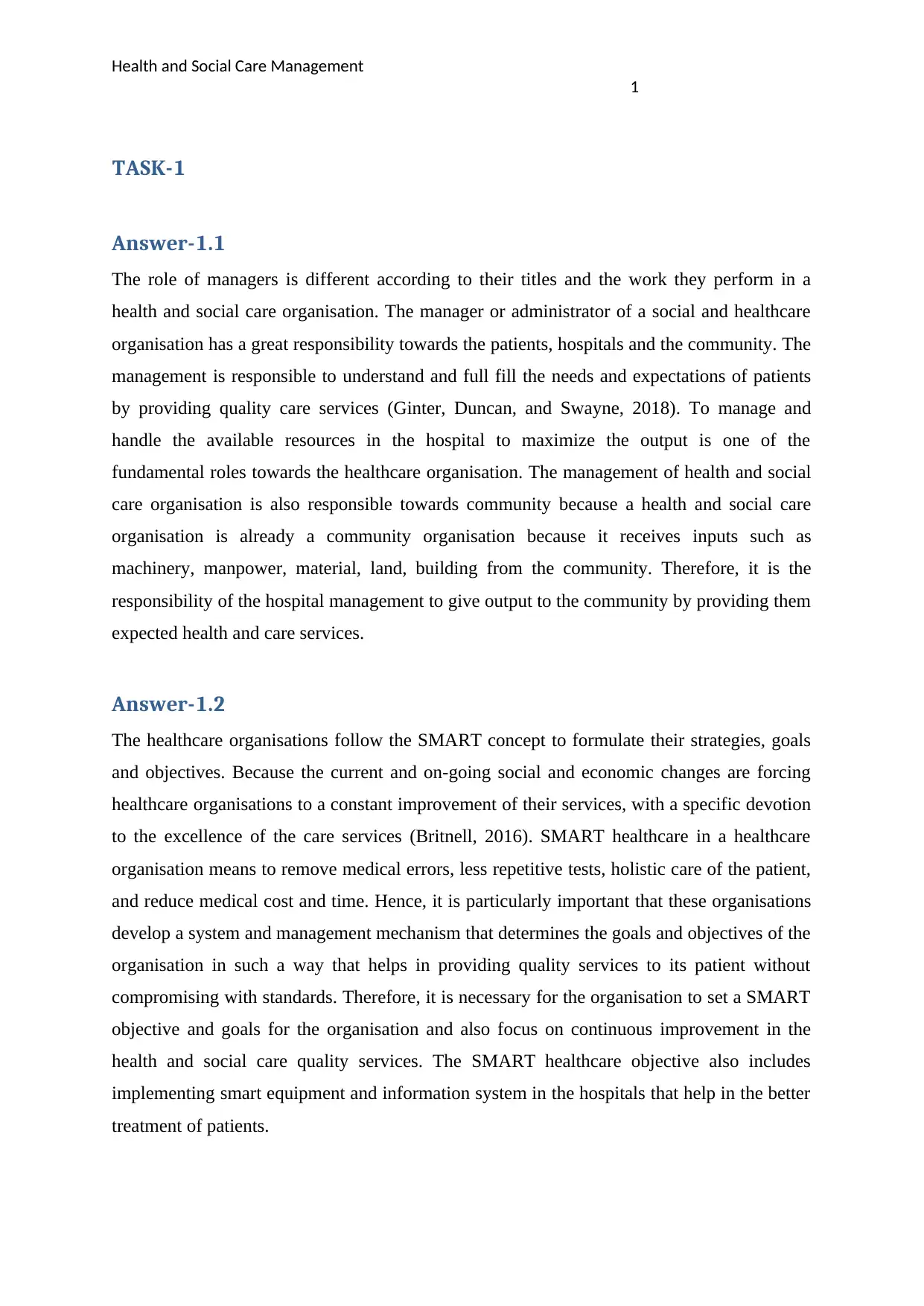
Health and Social Care Management
1
TASK-1
Answer-1.1
The role of managers is different according to their titles and the work they perform in a
health and social care organisation. The manager or administrator of a social and healthcare
organisation has a great responsibility towards the patients, hospitals and the community. The
management is responsible to understand and full fill the needs and expectations of patients
by providing quality care services (Ginter, Duncan, and Swayne, 2018). To manage and
handle the available resources in the hospital to maximize the output is one of the
fundamental roles towards the healthcare organisation. The management of health and social
care organisation is also responsible towards community because a health and social care
organisation is already a community organisation because it receives inputs such as
machinery, manpower, material, land, building from the community. Therefore, it is the
responsibility of the hospital management to give output to the community by providing them
expected health and care services.
Answer-1.2
The healthcare organisations follow the SMART concept to formulate their strategies, goals
and objectives. Because the current and on-going social and economic changes are forcing
healthcare organisations to a constant improvement of their services, with a specific devotion
to the excellence of the care services (Britnell, 2016). SMART healthcare in a healthcare
organisation means to remove medical errors, less repetitive tests, holistic care of the patient,
and reduce medical cost and time. Hence, it is particularly important that these organisations
develop a system and management mechanism that determines the goals and objectives of the
organisation in such a way that helps in providing quality services to its patient without
compromising with standards. Therefore, it is necessary for the organisation to set a SMART
objective and goals for the organisation and also focus on continuous improvement in the
health and social care quality services. The SMART healthcare objective also includes
implementing smart equipment and information system in the hospitals that help in the better
treatment of patients.
1
TASK-1
Answer-1.1
The role of managers is different according to their titles and the work they perform in a
health and social care organisation. The manager or administrator of a social and healthcare
organisation has a great responsibility towards the patients, hospitals and the community. The
management is responsible to understand and full fill the needs and expectations of patients
by providing quality care services (Ginter, Duncan, and Swayne, 2018). To manage and
handle the available resources in the hospital to maximize the output is one of the
fundamental roles towards the healthcare organisation. The management of health and social
care organisation is also responsible towards community because a health and social care
organisation is already a community organisation because it receives inputs such as
machinery, manpower, material, land, building from the community. Therefore, it is the
responsibility of the hospital management to give output to the community by providing them
expected health and care services.
Answer-1.2
The healthcare organisations follow the SMART concept to formulate their strategies, goals
and objectives. Because the current and on-going social and economic changes are forcing
healthcare organisations to a constant improvement of their services, with a specific devotion
to the excellence of the care services (Britnell, 2016). SMART healthcare in a healthcare
organisation means to remove medical errors, less repetitive tests, holistic care of the patient,
and reduce medical cost and time. Hence, it is particularly important that these organisations
develop a system and management mechanism that determines the goals and objectives of the
organisation in such a way that helps in providing quality services to its patient without
compromising with standards. Therefore, it is necessary for the organisation to set a SMART
objective and goals for the organisation and also focus on continuous improvement in the
health and social care quality services. The SMART healthcare objective also includes
implementing smart equipment and information system in the hospitals that help in the better
treatment of patients.
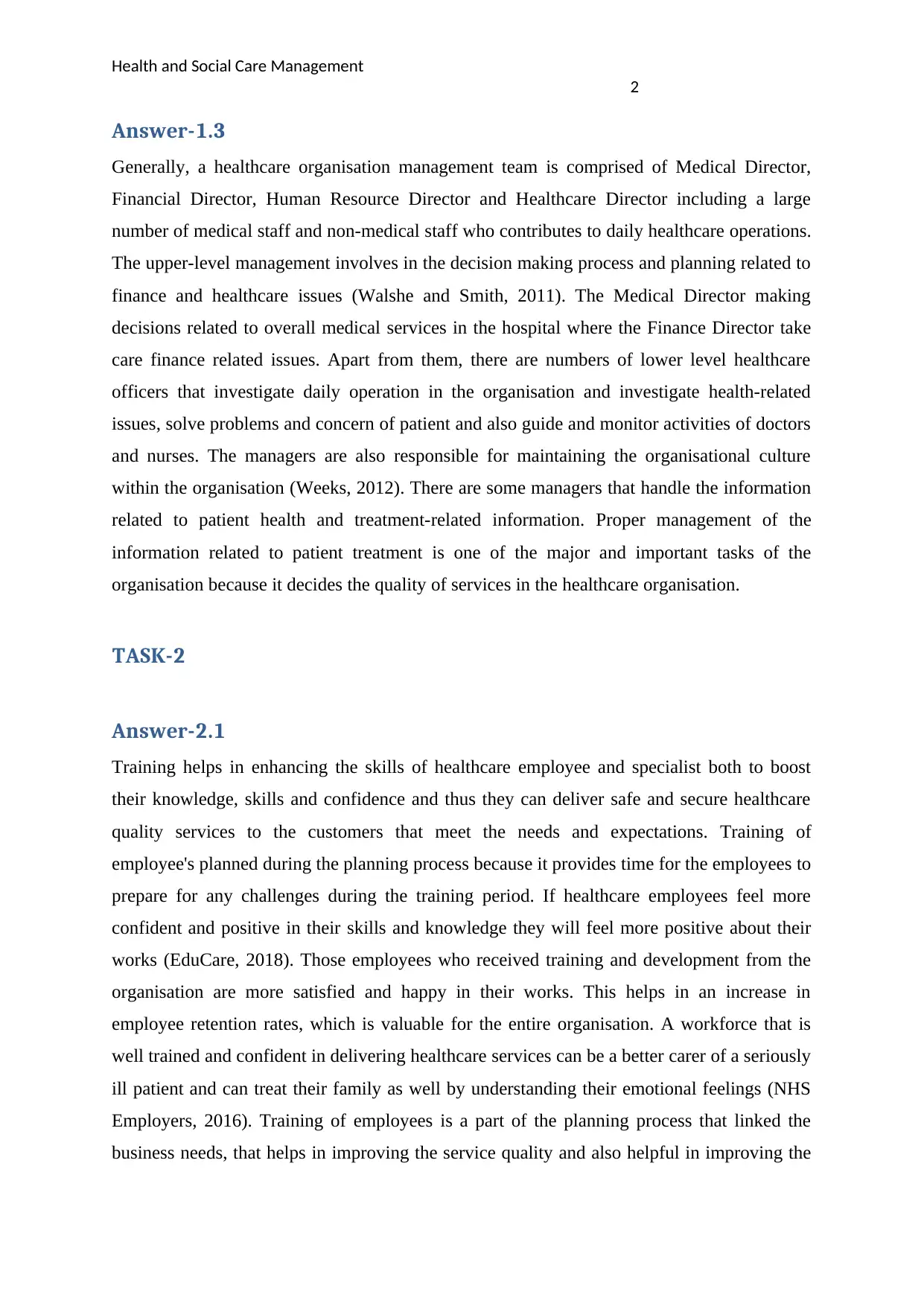
Health and Social Care Management
2
Answer-1.3
Generally, a healthcare organisation management team is comprised of Medical Director,
Financial Director, Human Resource Director and Healthcare Director including a large
number of medical staff and non-medical staff who contributes to daily healthcare operations.
The upper-level management involves in the decision making process and planning related to
finance and healthcare issues (Walshe and Smith, 2011). The Medical Director making
decisions related to overall medical services in the hospital where the Finance Director take
care finance related issues. Apart from them, there are numbers of lower level healthcare
officers that investigate daily operation in the organisation and investigate health-related
issues, solve problems and concern of patient and also guide and monitor activities of doctors
and nurses. The managers are also responsible for maintaining the organisational culture
within the organisation (Weeks, 2012). There are some managers that handle the information
related to patient health and treatment-related information. Proper management of the
information related to patient treatment is one of the major and important tasks of the
organisation because it decides the quality of services in the healthcare organisation.
TASK-2
Answer-2.1
Training helps in enhancing the skills of healthcare employee and specialist both to boost
their knowledge, skills and confidence and thus they can deliver safe and secure healthcare
quality services to the customers that meet the needs and expectations. Training of
employee's planned during the planning process because it provides time for the employees to
prepare for any challenges during the training period. If healthcare employees feel more
confident and positive in their skills and knowledge they will feel more positive about their
works (EduCare, 2018). Those employees who received training and development from the
organisation are more satisfied and happy in their works. This helps in an increase in
employee retention rates, which is valuable for the entire organisation. A workforce that is
well trained and confident in delivering healthcare services can be a better carer of a seriously
ill patient and can treat their family as well by understanding their emotional feelings (NHS
Employers, 2016). Training of employees is a part of the planning process that linked the
business needs, that helps in improving the service quality and also helpful in improving the
2
Answer-1.3
Generally, a healthcare organisation management team is comprised of Medical Director,
Financial Director, Human Resource Director and Healthcare Director including a large
number of medical staff and non-medical staff who contributes to daily healthcare operations.
The upper-level management involves in the decision making process and planning related to
finance and healthcare issues (Walshe and Smith, 2011). The Medical Director making
decisions related to overall medical services in the hospital where the Finance Director take
care finance related issues. Apart from them, there are numbers of lower level healthcare
officers that investigate daily operation in the organisation and investigate health-related
issues, solve problems and concern of patient and also guide and monitor activities of doctors
and nurses. The managers are also responsible for maintaining the organisational culture
within the organisation (Weeks, 2012). There are some managers that handle the information
related to patient health and treatment-related information. Proper management of the
information related to patient treatment is one of the major and important tasks of the
organisation because it decides the quality of services in the healthcare organisation.
TASK-2
Answer-2.1
Training helps in enhancing the skills of healthcare employee and specialist both to boost
their knowledge, skills and confidence and thus they can deliver safe and secure healthcare
quality services to the customers that meet the needs and expectations. Training of
employee's planned during the planning process because it provides time for the employees to
prepare for any challenges during the training period. If healthcare employees feel more
confident and positive in their skills and knowledge they will feel more positive about their
works (EduCare, 2018). Those employees who received training and development from the
organisation are more satisfied and happy in their works. This helps in an increase in
employee retention rates, which is valuable for the entire organisation. A workforce that is
well trained and confident in delivering healthcare services can be a better carer of a seriously
ill patient and can treat their family as well by understanding their emotional feelings (NHS
Employers, 2016). Training of employees is a part of the planning process that linked the
business needs, that helps in improving the service quality and also helpful in improving the
⊘ This is a preview!⊘
Do you want full access?
Subscribe today to unlock all pages.

Trusted by 1+ million students worldwide
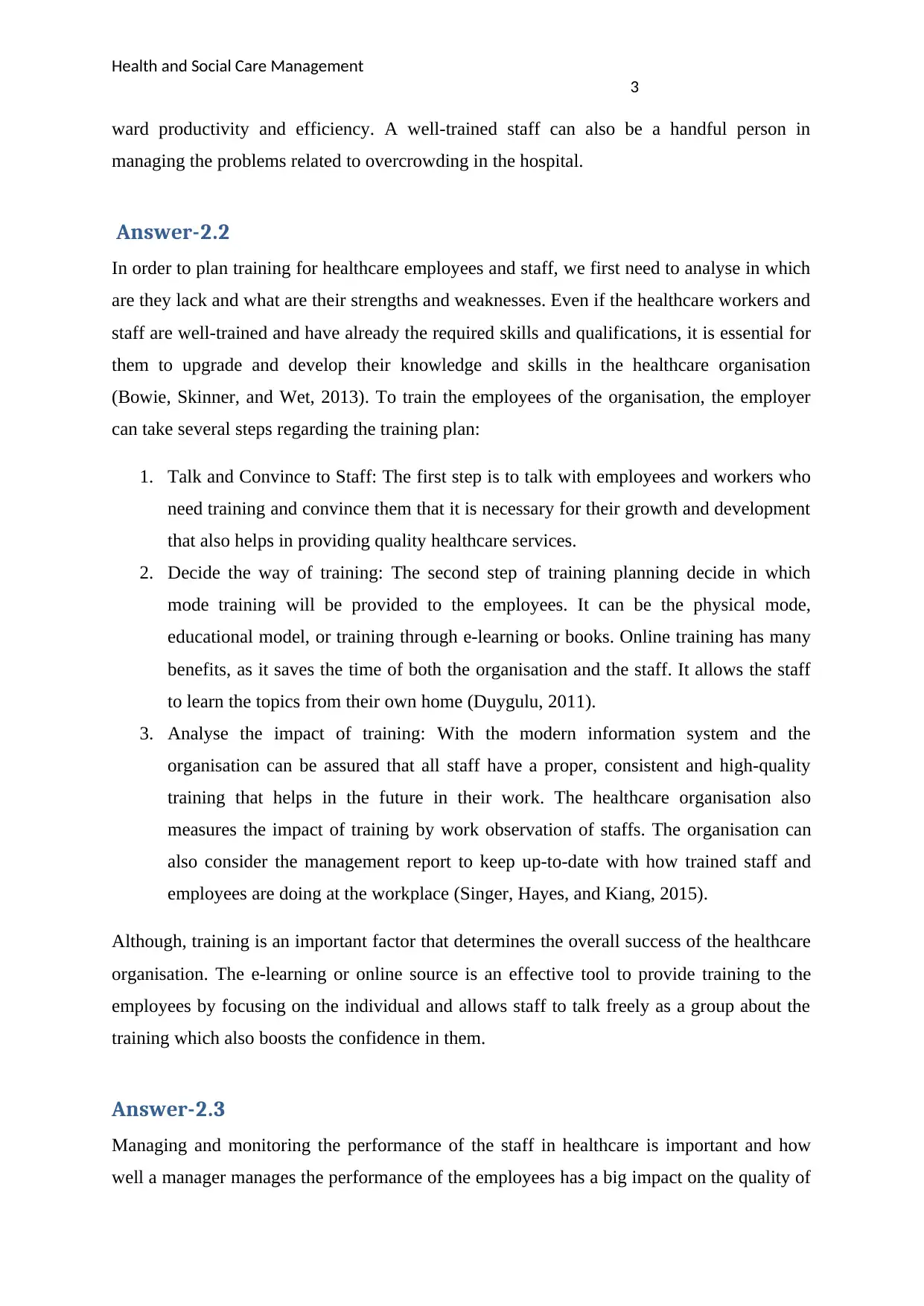
Health and Social Care Management
3
ward productivity and efficiency. A well-trained staff can also be a handful person in
managing the problems related to overcrowding in the hospital.
Answer-2.2
In order to plan training for healthcare employees and staff, we first need to analyse in which
are they lack and what are their strengths and weaknesses. Even if the healthcare workers and
staff are well-trained and have already the required skills and qualifications, it is essential for
them to upgrade and develop their knowledge and skills in the healthcare organisation
(Bowie, Skinner, and Wet, 2013). To train the employees of the organisation, the employer
can take several steps regarding the training plan:
1. Talk and Convince to Staff: The first step is to talk with employees and workers who
need training and convince them that it is necessary for their growth and development
that also helps in providing quality healthcare services.
2. Decide the way of training: The second step of training planning decide in which
mode training will be provided to the employees. It can be the physical mode,
educational model, or training through e-learning or books. Online training has many
benefits, as it saves the time of both the organisation and the staff. It allows the staff
to learn the topics from their own home (Duygulu, 2011).
3. Analyse the impact of training: With the modern information system and the
organisation can be assured that all staff have a proper, consistent and high-quality
training that helps in the future in their work. The healthcare organisation also
measures the impact of training by work observation of staffs. The organisation can
also consider the management report to keep up-to-date with how trained staff and
employees are doing at the workplace (Singer, Hayes, and Kiang, 2015).
Although, training is an important factor that determines the overall success of the healthcare
organisation. The e-learning or online source is an effective tool to provide training to the
employees by focusing on the individual and allows staff to talk freely as a group about the
training which also boosts the confidence in them.
Answer-2.3
Managing and monitoring the performance of the staff in healthcare is important and how
well a manager manages the performance of the employees has a big impact on the quality of
3
ward productivity and efficiency. A well-trained staff can also be a handful person in
managing the problems related to overcrowding in the hospital.
Answer-2.2
In order to plan training for healthcare employees and staff, we first need to analyse in which
are they lack and what are their strengths and weaknesses. Even if the healthcare workers and
staff are well-trained and have already the required skills and qualifications, it is essential for
them to upgrade and develop their knowledge and skills in the healthcare organisation
(Bowie, Skinner, and Wet, 2013). To train the employees of the organisation, the employer
can take several steps regarding the training plan:
1. Talk and Convince to Staff: The first step is to talk with employees and workers who
need training and convince them that it is necessary for their growth and development
that also helps in providing quality healthcare services.
2. Decide the way of training: The second step of training planning decide in which
mode training will be provided to the employees. It can be the physical mode,
educational model, or training through e-learning or books. Online training has many
benefits, as it saves the time of both the organisation and the staff. It allows the staff
to learn the topics from their own home (Duygulu, 2011).
3. Analyse the impact of training: With the modern information system and the
organisation can be assured that all staff have a proper, consistent and high-quality
training that helps in the future in their work. The healthcare organisation also
measures the impact of training by work observation of staffs. The organisation can
also consider the management report to keep up-to-date with how trained staff and
employees are doing at the workplace (Singer, Hayes, and Kiang, 2015).
Although, training is an important factor that determines the overall success of the healthcare
organisation. The e-learning or online source is an effective tool to provide training to the
employees by focusing on the individual and allows staff to talk freely as a group about the
training which also boosts the confidence in them.
Answer-2.3
Managing and monitoring the performance of the staff in healthcare is important and how
well a manager manages the performance of the employees has a big impact on the quality of
Paraphrase This Document
Need a fresh take? Get an instant paraphrase of this document with our AI Paraphraser
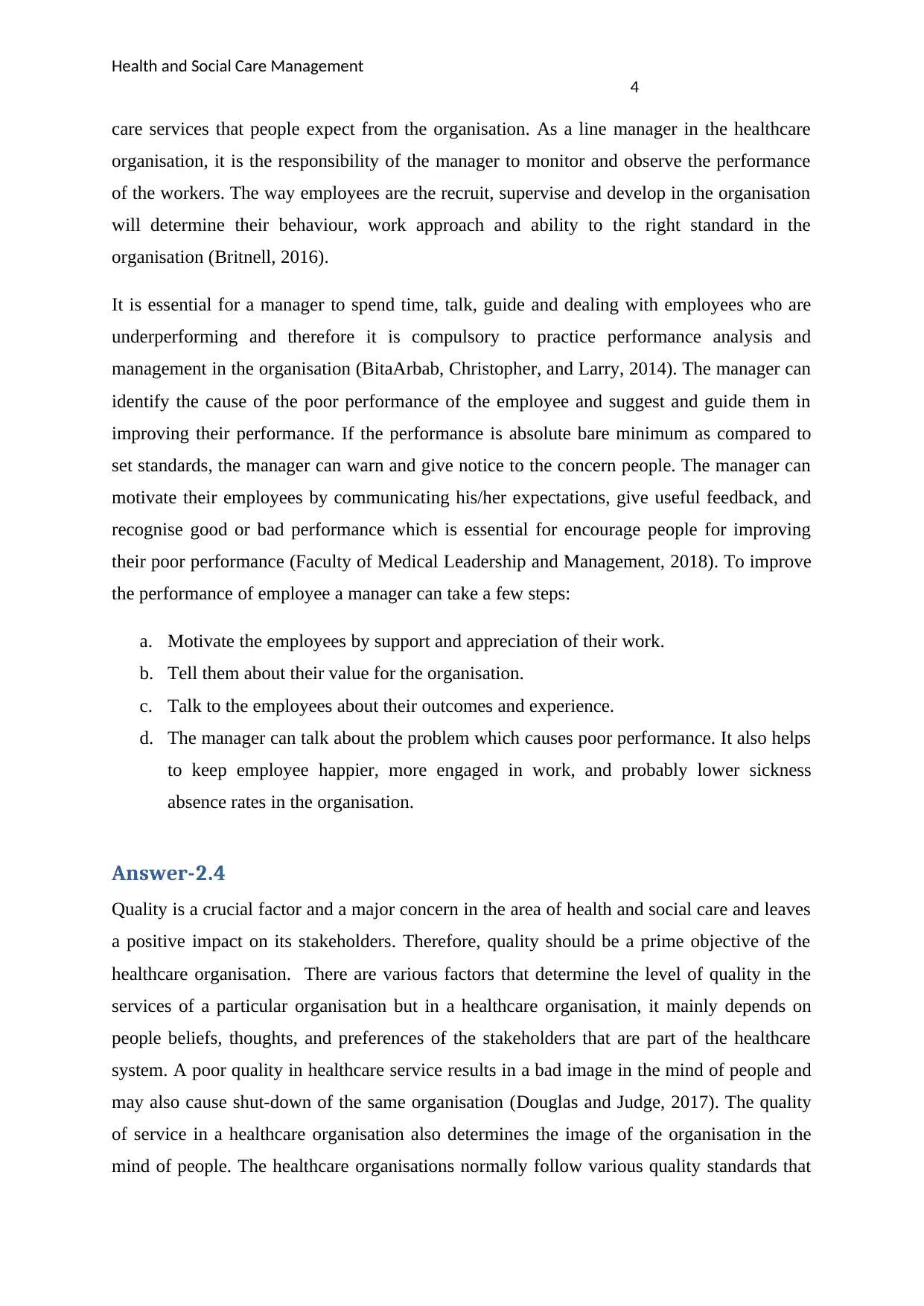
Health and Social Care Management
4
care services that people expect from the organisation. As a line manager in the healthcare
organisation, it is the responsibility of the manager to monitor and observe the performance
of the workers. The way employees are the recruit, supervise and develop in the organisation
will determine their behaviour, work approach and ability to the right standard in the
organisation (Britnell, 2016).
It is essential for a manager to spend time, talk, guide and dealing with employees who are
underperforming and therefore it is compulsory to practice performance analysis and
management in the organisation (BitaArbab, Christopher, and Larry, 2014). The manager can
identify the cause of the poor performance of the employee and suggest and guide them in
improving their performance. If the performance is absolute bare minimum as compared to
set standards, the manager can warn and give notice to the concern people. The manager can
motivate their employees by communicating his/her expectations, give useful feedback, and
recognise good or bad performance which is essential for encourage people for improving
their poor performance (Faculty of Medical Leadership and Management, 2018). To improve
the performance of employee a manager can take a few steps:
a. Motivate the employees by support and appreciation of their work.
b. Tell them about their value for the organisation.
c. Talk to the employees about their outcomes and experience.
d. The manager can talk about the problem which causes poor performance. It also helps
to keep employee happier, more engaged in work, and probably lower sickness
absence rates in the organisation.
Answer-2.4
Quality is a crucial factor and a major concern in the area of health and social care and leaves
a positive impact on its stakeholders. Therefore, quality should be a prime objective of the
healthcare organisation. There are various factors that determine the level of quality in the
services of a particular organisation but in a healthcare organisation, it mainly depends on
people beliefs, thoughts, and preferences of the stakeholders that are part of the healthcare
system. A poor quality in healthcare service results in a bad image in the mind of people and
may also cause shut-down of the same organisation (Douglas and Judge, 2017). The quality
of service in a healthcare organisation also determines the image of the organisation in the
mind of people. The healthcare organisations normally follow various quality standards that
4
care services that people expect from the organisation. As a line manager in the healthcare
organisation, it is the responsibility of the manager to monitor and observe the performance
of the workers. The way employees are the recruit, supervise and develop in the organisation
will determine their behaviour, work approach and ability to the right standard in the
organisation (Britnell, 2016).
It is essential for a manager to spend time, talk, guide and dealing with employees who are
underperforming and therefore it is compulsory to practice performance analysis and
management in the organisation (BitaArbab, Christopher, and Larry, 2014). The manager can
identify the cause of the poor performance of the employee and suggest and guide them in
improving their performance. If the performance is absolute bare minimum as compared to
set standards, the manager can warn and give notice to the concern people. The manager can
motivate their employees by communicating his/her expectations, give useful feedback, and
recognise good or bad performance which is essential for encourage people for improving
their poor performance (Faculty of Medical Leadership and Management, 2018). To improve
the performance of employee a manager can take a few steps:
a. Motivate the employees by support and appreciation of their work.
b. Tell them about their value for the organisation.
c. Talk to the employees about their outcomes and experience.
d. The manager can talk about the problem which causes poor performance. It also helps
to keep employee happier, more engaged in work, and probably lower sickness
absence rates in the organisation.
Answer-2.4
Quality is a crucial factor and a major concern in the area of health and social care and leaves
a positive impact on its stakeholders. Therefore, quality should be a prime objective of the
healthcare organisation. There are various factors that determine the level of quality in the
services of a particular organisation but in a healthcare organisation, it mainly depends on
people beliefs, thoughts, and preferences of the stakeholders that are part of the healthcare
system. A poor quality in healthcare service results in a bad image in the mind of people and
may also cause shut-down of the same organisation (Douglas and Judge, 2017). The quality
of service in a healthcare organisation also determines the image of the organisation in the
mind of people. The healthcare organisations normally follow various quality standards that
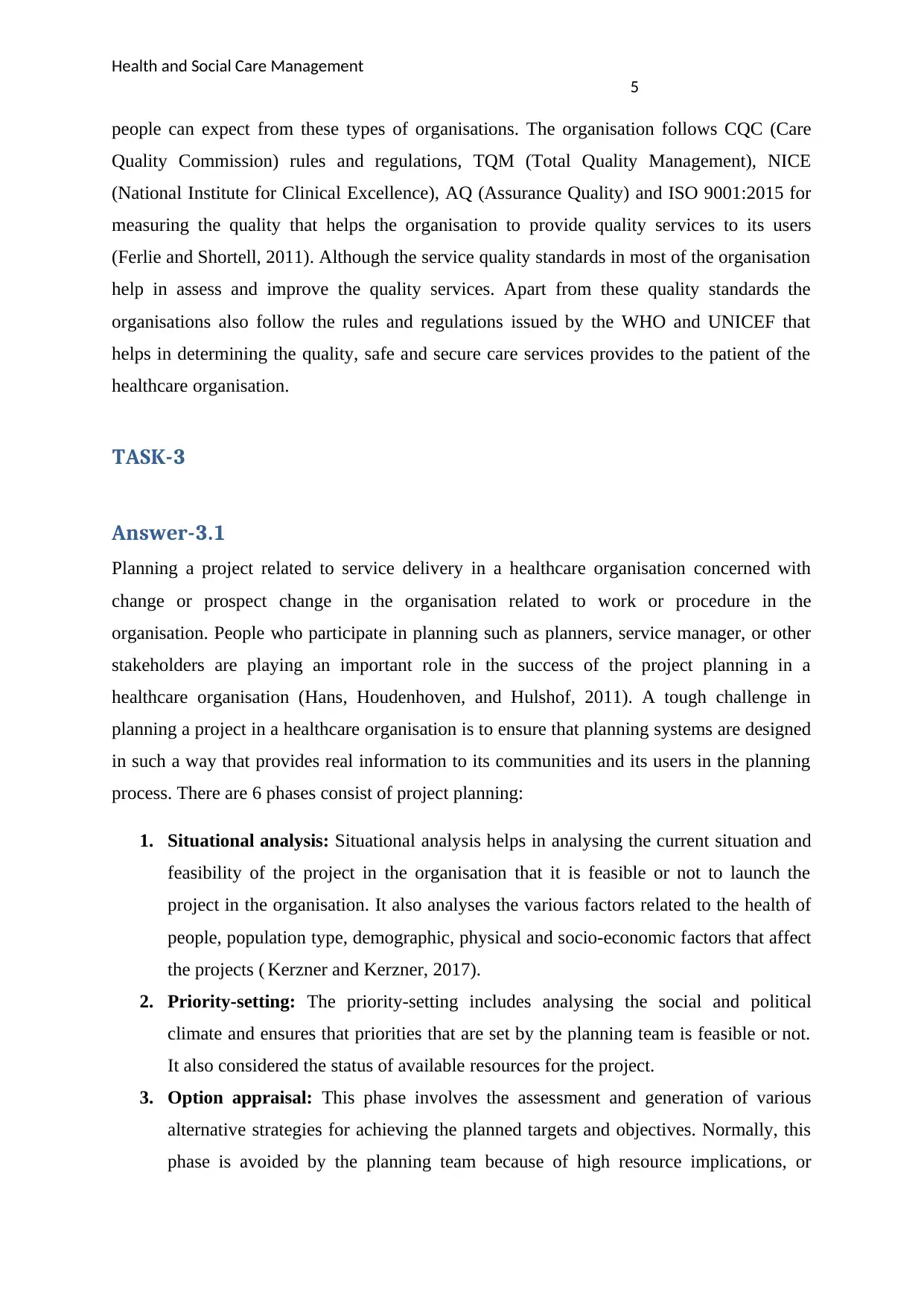
Health and Social Care Management
5
people can expect from these types of organisations. The organisation follows CQC (Care
Quality Commission) rules and regulations, TQM (Total Quality Management), NICE
(National Institute for Clinical Excellence), AQ (Assurance Quality) and ISO 9001:2015 for
measuring the quality that helps the organisation to provide quality services to its users
(Ferlie and Shortell, 2011). Although the service quality standards in most of the organisation
help in assess and improve the quality services. Apart from these quality standards the
organisations also follow the rules and regulations issued by the WHO and UNICEF that
helps in determining the quality, safe and secure care services provides to the patient of the
healthcare organisation.
TASK-3
Answer-3.1
Planning a project related to service delivery in a healthcare organisation concerned with
change or prospect change in the organisation related to work or procedure in the
organisation. People who participate in planning such as planners, service manager, or other
stakeholders are playing an important role in the success of the project planning in a
healthcare organisation (Hans, Houdenhoven, and Hulshof, 2011). A tough challenge in
planning a project in a healthcare organisation is to ensure that planning systems are designed
in such a way that provides real information to its communities and its users in the planning
process. There are 6 phases consist of project planning:
1. Situational analysis: Situational analysis helps in analysing the current situation and
feasibility of the project in the organisation that it is feasible or not to launch the
project in the organisation. It also analyses the various factors related to the health of
people, population type, demographic, physical and socio-economic factors that affect
the projects ( Kerzner and Kerzner, 2017).
2. Priority-setting: The priority-setting includes analysing the social and political
climate and ensures that priorities that are set by the planning team is feasible or not.
It also considered the status of available resources for the project.
3. Option appraisal: This phase involves the assessment and generation of various
alternative strategies for achieving the planned targets and objectives. Normally, this
phase is avoided by the planning team because of high resource implications, or
5
people can expect from these types of organisations. The organisation follows CQC (Care
Quality Commission) rules and regulations, TQM (Total Quality Management), NICE
(National Institute for Clinical Excellence), AQ (Assurance Quality) and ISO 9001:2015 for
measuring the quality that helps the organisation to provide quality services to its users
(Ferlie and Shortell, 2011). Although the service quality standards in most of the organisation
help in assess and improve the quality services. Apart from these quality standards the
organisations also follow the rules and regulations issued by the WHO and UNICEF that
helps in determining the quality, safe and secure care services provides to the patient of the
healthcare organisation.
TASK-3
Answer-3.1
Planning a project related to service delivery in a healthcare organisation concerned with
change or prospect change in the organisation related to work or procedure in the
organisation. People who participate in planning such as planners, service manager, or other
stakeholders are playing an important role in the success of the project planning in a
healthcare organisation (Hans, Houdenhoven, and Hulshof, 2011). A tough challenge in
planning a project in a healthcare organisation is to ensure that planning systems are designed
in such a way that provides real information to its communities and its users in the planning
process. There are 6 phases consist of project planning:
1. Situational analysis: Situational analysis helps in analysing the current situation and
feasibility of the project in the organisation that it is feasible or not to launch the
project in the organisation. It also analyses the various factors related to the health of
people, population type, demographic, physical and socio-economic factors that affect
the projects ( Kerzner and Kerzner, 2017).
2. Priority-setting: The priority-setting includes analysing the social and political
climate and ensures that priorities that are set by the planning team is feasible or not.
It also considered the status of available resources for the project.
3. Option appraisal: This phase involves the assessment and generation of various
alternative strategies for achieving the planned targets and objectives. Normally, this
phase is avoided by the planning team because of high resource implications, or
⊘ This is a preview!⊘
Do you want full access?
Subscribe today to unlock all pages.

Trusted by 1+ million students worldwide
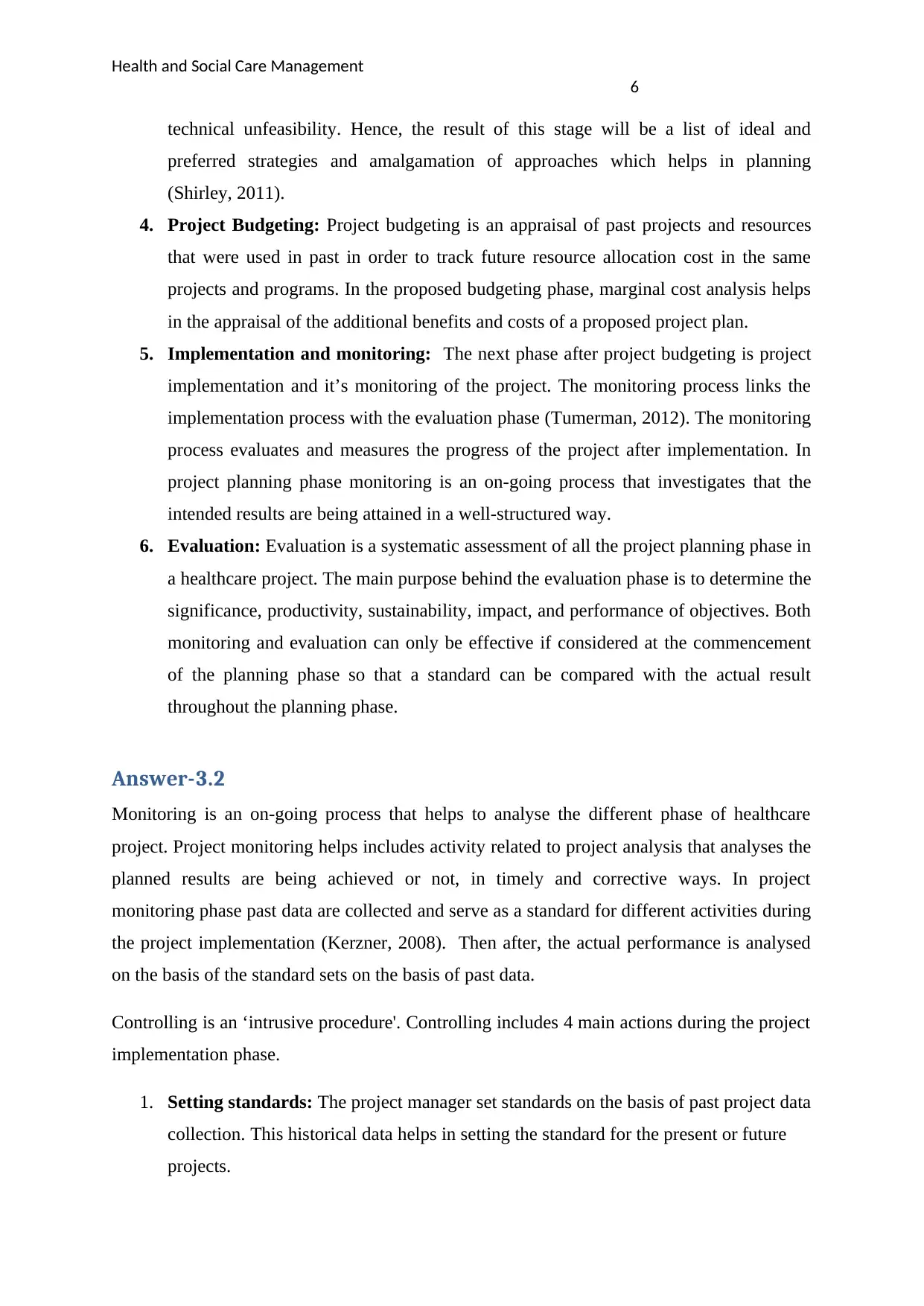
Health and Social Care Management
6
technical unfeasibility. Hence, the result of this stage will be a list of ideal and
preferred strategies and amalgamation of approaches which helps in planning
(Shirley, 2011).
4. Project Budgeting: Project budgeting is an appraisal of past projects and resources
that were used in past in order to track future resource allocation cost in the same
projects and programs. In the proposed budgeting phase, marginal cost analysis helps
in the appraisal of the additional benefits and costs of a proposed project plan.
5. Implementation and monitoring: The next phase after project budgeting is project
implementation and it’s monitoring of the project. The monitoring process links the
implementation process with the evaluation phase (Tumerman, 2012). The monitoring
process evaluates and measures the progress of the project after implementation. In
project planning phase monitoring is an on-going process that investigates that the
intended results are being attained in a well-structured way.
6. Evaluation: Evaluation is a systematic assessment of all the project planning phase in
a healthcare project. The main purpose behind the evaluation phase is to determine the
significance, productivity, sustainability, impact, and performance of objectives. Both
monitoring and evaluation can only be effective if considered at the commencement
of the planning phase so that a standard can be compared with the actual result
throughout the planning phase.
Answer-3.2
Monitoring is an on-going process that helps to analyse the different phase of healthcare
project. Project monitoring helps includes activity related to project analysis that analyses the
planned results are being achieved or not, in timely and corrective ways. In project
monitoring phase past data are collected and serve as a standard for different activities during
the project implementation (Kerzner, 2008). Then after, the actual performance is analysed
on the basis of the standard sets on the basis of past data.
Controlling is an ‘intrusive procedure'. Controlling includes 4 main actions during the project
implementation phase.
1. Setting standards: The project manager set standards on the basis of past project data
collection. This historical data helps in setting the standard for the present or future
projects.
6
technical unfeasibility. Hence, the result of this stage will be a list of ideal and
preferred strategies and amalgamation of approaches which helps in planning
(Shirley, 2011).
4. Project Budgeting: Project budgeting is an appraisal of past projects and resources
that were used in past in order to track future resource allocation cost in the same
projects and programs. In the proposed budgeting phase, marginal cost analysis helps
in the appraisal of the additional benefits and costs of a proposed project plan.
5. Implementation and monitoring: The next phase after project budgeting is project
implementation and it’s monitoring of the project. The monitoring process links the
implementation process with the evaluation phase (Tumerman, 2012). The monitoring
process evaluates and measures the progress of the project after implementation. In
project planning phase monitoring is an on-going process that investigates that the
intended results are being attained in a well-structured way.
6. Evaluation: Evaluation is a systematic assessment of all the project planning phase in
a healthcare project. The main purpose behind the evaluation phase is to determine the
significance, productivity, sustainability, impact, and performance of objectives. Both
monitoring and evaluation can only be effective if considered at the commencement
of the planning phase so that a standard can be compared with the actual result
throughout the planning phase.
Answer-3.2
Monitoring is an on-going process that helps to analyse the different phase of healthcare
project. Project monitoring helps includes activity related to project analysis that analyses the
planned results are being achieved or not, in timely and corrective ways. In project
monitoring phase past data are collected and serve as a standard for different activities during
the project implementation (Kerzner, 2008). Then after, the actual performance is analysed
on the basis of the standard sets on the basis of past data.
Controlling is an ‘intrusive procedure'. Controlling includes 4 main actions during the project
implementation phase.
1. Setting standards: The project manager set standards on the basis of past project data
collection. This historical data helps in setting the standard for the present or future
projects.
Paraphrase This Document
Need a fresh take? Get an instant paraphrase of this document with our AI Paraphraser
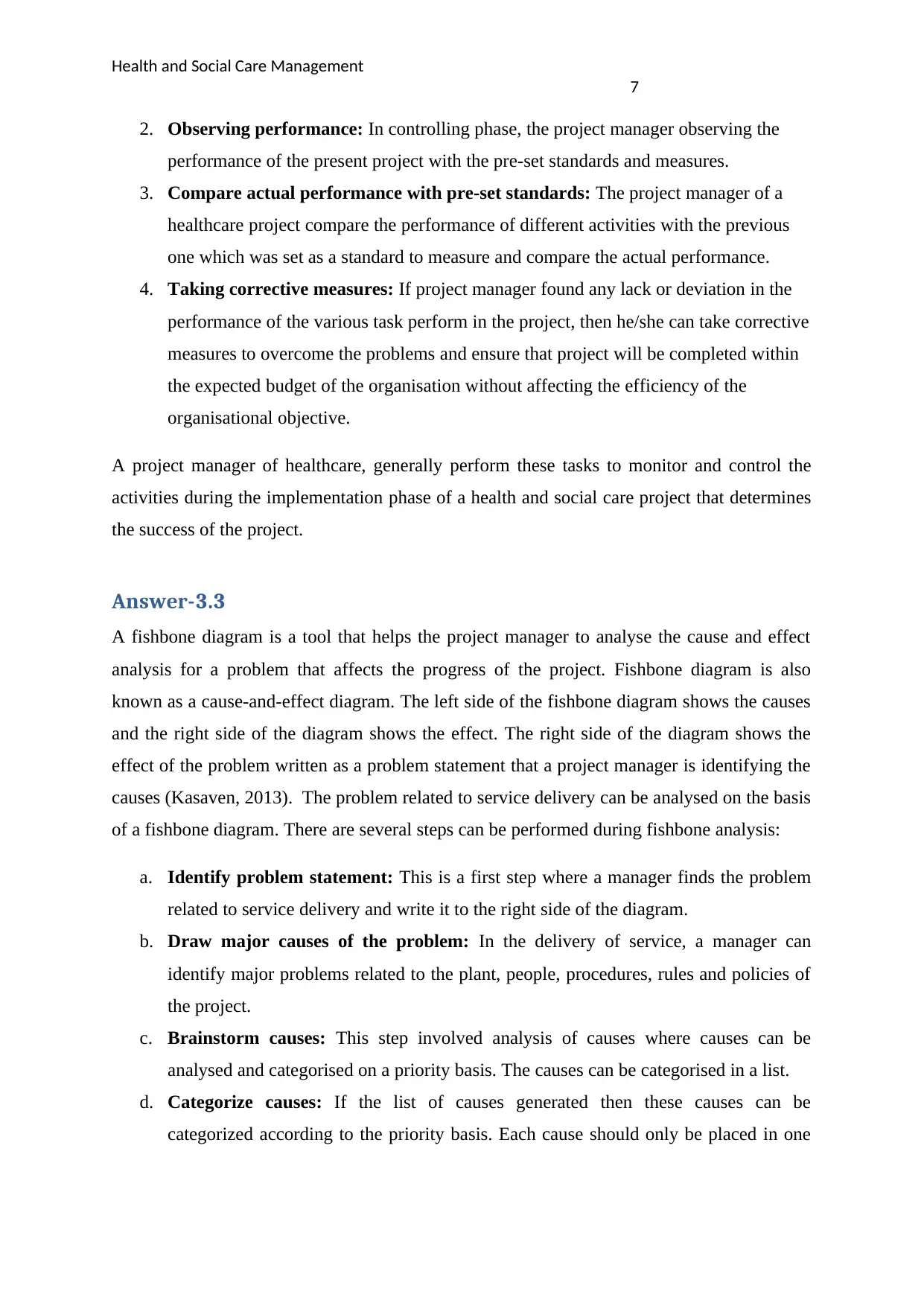
Health and Social Care Management
7
2. Observing performance: In controlling phase, the project manager observing the
performance of the present project with the pre-set standards and measures.
3. Compare actual performance with pre-set standards: The project manager of a
healthcare project compare the performance of different activities with the previous
one which was set as a standard to measure and compare the actual performance.
4. Taking corrective measures: If project manager found any lack or deviation in the
performance of the various task perform in the project, then he/she can take corrective
measures to overcome the problems and ensure that project will be completed within
the expected budget of the organisation without affecting the efficiency of the
organisational objective.
A project manager of healthcare, generally perform these tasks to monitor and control the
activities during the implementation phase of a health and social care project that determines
the success of the project.
Answer-3.3
A fishbone diagram is a tool that helps the project manager to analyse the cause and effect
analysis for a problem that affects the progress of the project. Fishbone diagram is also
known as a cause-and-effect diagram. The left side of the fishbone diagram shows the causes
and the right side of the diagram shows the effect. The right side of the diagram shows the
effect of the problem written as a problem statement that a project manager is identifying the
causes (Kasaven, 2013). The problem related to service delivery can be analysed on the basis
of a fishbone diagram. There are several steps can be performed during fishbone analysis:
a. Identify problem statement: This is a first step where a manager finds the problem
related to service delivery and write it to the right side of the diagram.
b. Draw major causes of the problem: In the delivery of service, a manager can
identify major problems related to the plant, people, procedures, rules and policies of
the project.
c. Brainstorm causes: This step involved analysis of causes where causes can be
analysed and categorised on a priority basis. The causes can be categorised in a list.
d. Categorize causes: If the list of causes generated then these causes can be
categorized according to the priority basis. Each cause should only be placed in one
7
2. Observing performance: In controlling phase, the project manager observing the
performance of the present project with the pre-set standards and measures.
3. Compare actual performance with pre-set standards: The project manager of a
healthcare project compare the performance of different activities with the previous
one which was set as a standard to measure and compare the actual performance.
4. Taking corrective measures: If project manager found any lack or deviation in the
performance of the various task perform in the project, then he/she can take corrective
measures to overcome the problems and ensure that project will be completed within
the expected budget of the organisation without affecting the efficiency of the
organisational objective.
A project manager of healthcare, generally perform these tasks to monitor and control the
activities during the implementation phase of a health and social care project that determines
the success of the project.
Answer-3.3
A fishbone diagram is a tool that helps the project manager to analyse the cause and effect
analysis for a problem that affects the progress of the project. Fishbone diagram is also
known as a cause-and-effect diagram. The left side of the fishbone diagram shows the causes
and the right side of the diagram shows the effect. The right side of the diagram shows the
effect of the problem written as a problem statement that a project manager is identifying the
causes (Kasaven, 2013). The problem related to service delivery can be analysed on the basis
of a fishbone diagram. There are several steps can be performed during fishbone analysis:
a. Identify problem statement: This is a first step where a manager finds the problem
related to service delivery and write it to the right side of the diagram.
b. Draw major causes of the problem: In the delivery of service, a manager can
identify major problems related to the plant, people, procedures, rules and policies of
the project.
c. Brainstorm causes: This step involved analysis of causes where causes can be
analysed and categorised on a priority basis. The causes can be categorised in a list.
d. Categorize causes: If the list of causes generated then these causes can be
categorized according to the priority basis. Each cause should only be placed in one
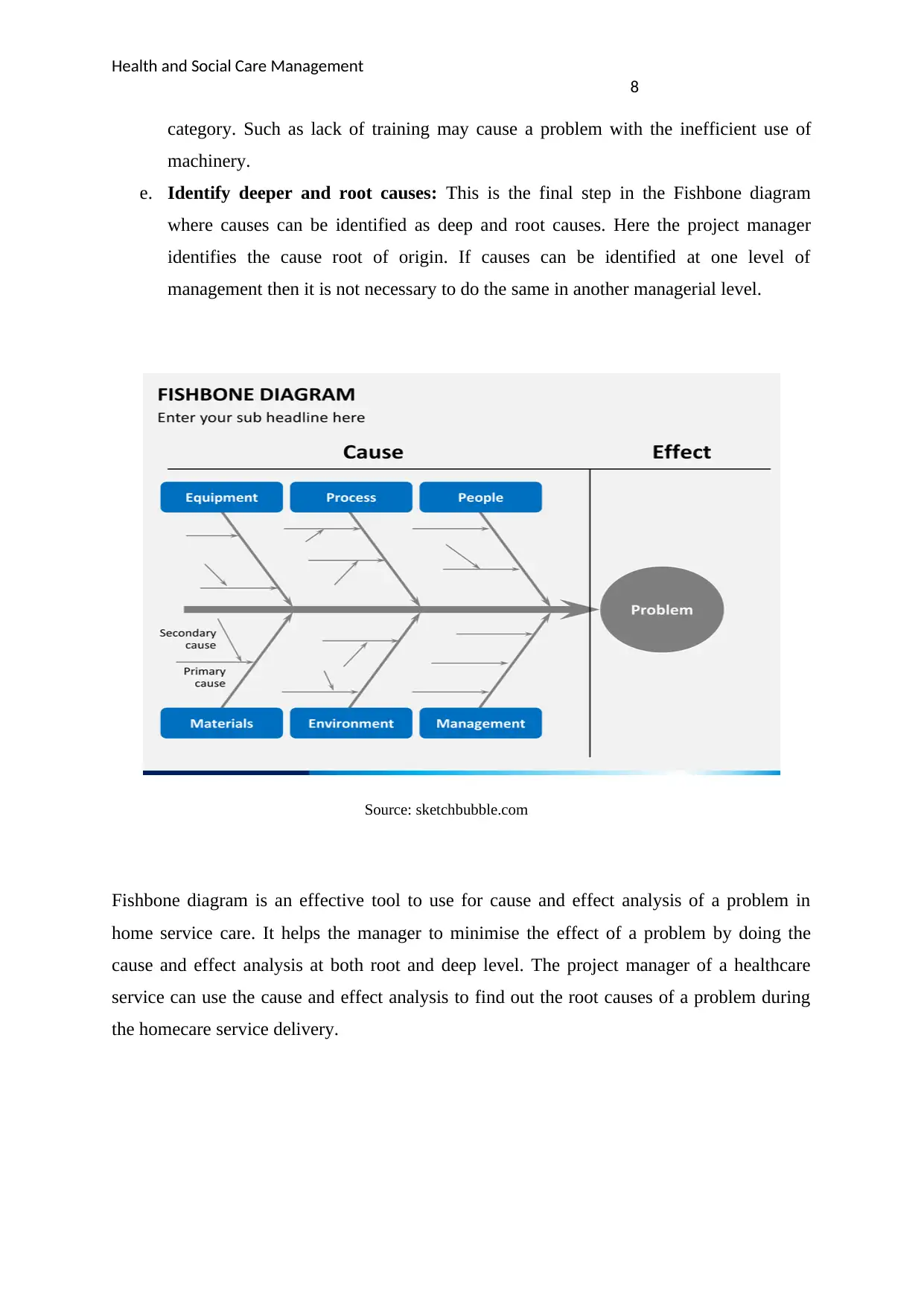
Health and Social Care Management
8
category. Such as lack of training may cause a problem with the inefficient use of
machinery.
e. Identify deeper and root causes: This is the final step in the Fishbone diagram
where causes can be identified as deep and root causes. Here the project manager
identifies the cause root of origin. If causes can be identified at one level of
management then it is not necessary to do the same in another managerial level.
Source: sketchbubble.com
Fishbone diagram is an effective tool to use for cause and effect analysis of a problem in
home service care. It helps the manager to minimise the effect of a problem by doing the
cause and effect analysis at both root and deep level. The project manager of a healthcare
service can use the cause and effect analysis to find out the root causes of a problem during
the homecare service delivery.
8
category. Such as lack of training may cause a problem with the inefficient use of
machinery.
e. Identify deeper and root causes: This is the final step in the Fishbone diagram
where causes can be identified as deep and root causes. Here the project manager
identifies the cause root of origin. If causes can be identified at one level of
management then it is not necessary to do the same in another managerial level.
Source: sketchbubble.com
Fishbone diagram is an effective tool to use for cause and effect analysis of a problem in
home service care. It helps the manager to minimise the effect of a problem by doing the
cause and effect analysis at both root and deep level. The project manager of a healthcare
service can use the cause and effect analysis to find out the root causes of a problem during
the homecare service delivery.
⊘ This is a preview!⊘
Do you want full access?
Subscribe today to unlock all pages.

Trusted by 1+ million students worldwide
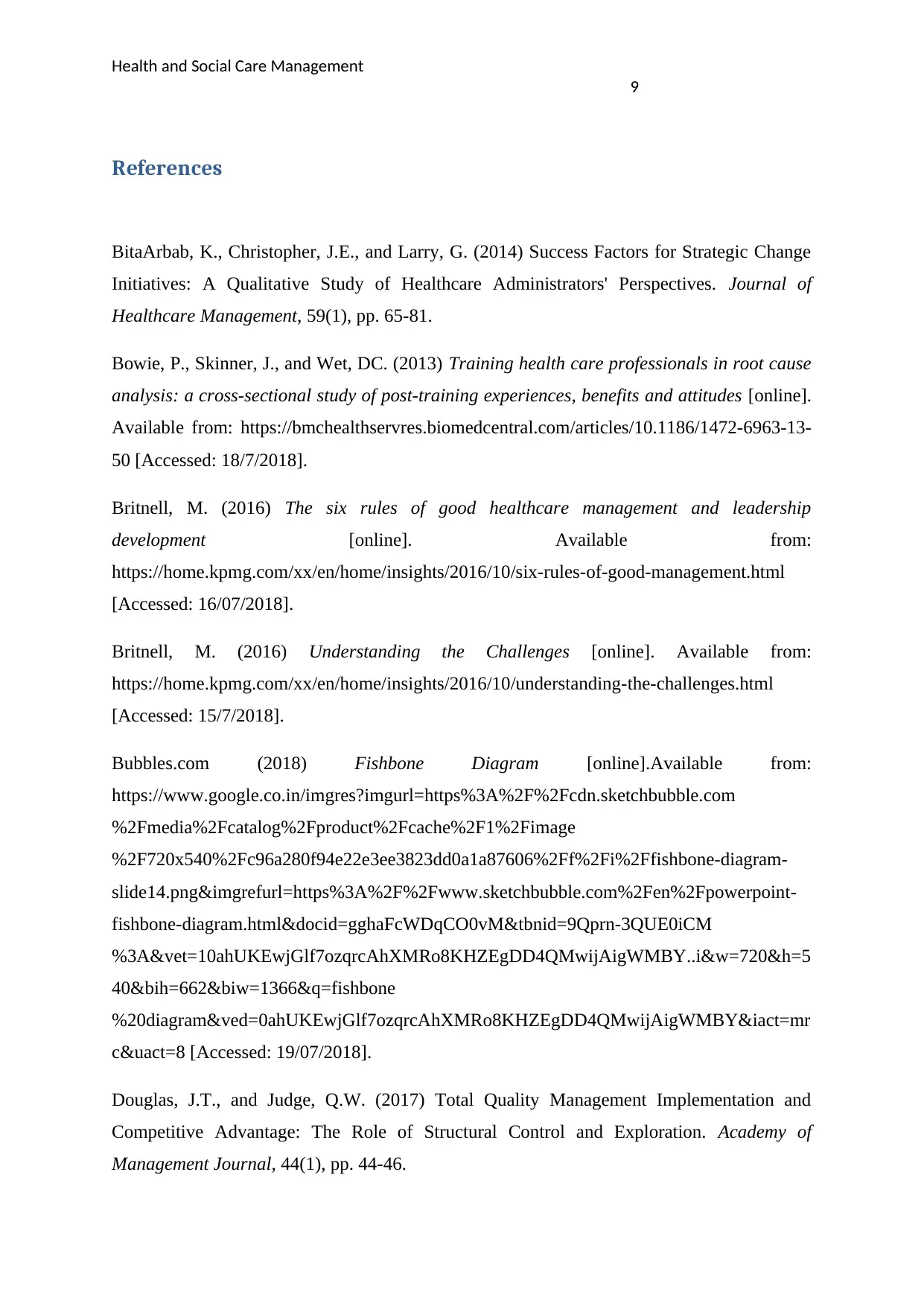
Health and Social Care Management
9
References
BitaArbab, K., Christopher, J.E., and Larry, G. (2014) Success Factors for Strategic Change
Initiatives: A Qualitative Study of Healthcare Administrators' Perspectives. Journal of
Healthcare Management, 59(1), pp. 65-81.
Bowie, P., Skinner, J., and Wet, DC. (2013) Training health care professionals in root cause
analysis: a cross-sectional study of post-training experiences, benefits and attitudes [online].
Available from: https://bmchealthservres.biomedcentral.com/articles/10.1186/1472-6963-13-
50 [Accessed: 18/7/2018].
Britnell, M. (2016) The six rules of good healthcare management and leadership
development [online]. Available from:
https://home.kpmg.com/xx/en/home/insights/2016/10/six-rules-of-good-management.html
[Accessed: 16/07/2018].
Britnell, M. (2016) Understanding the Challenges [online]. Available from:
https://home.kpmg.com/xx/en/home/insights/2016/10/understanding-the-challenges.html
[Accessed: 15/7/2018].
Bubbles.com (2018) Fishbone Diagram [online].Available from:
https://www.google.co.in/imgres?imgurl=https%3A%2F%2Fcdn.sketchbubble.com
%2Fmedia%2Fcatalog%2Fproduct%2Fcache%2F1%2Fimage
%2F720x540%2Fc96a280f94e22e3ee3823dd0a1a87606%2Ff%2Fi%2Ffishbone-diagram-
slide14.png&imgrefurl=https%3A%2F%2Fwww.sketchbubble.com%2Fen%2Fpowerpoint-
fishbone-diagram.html&docid=gghaFcWDqCO0vM&tbnid=9Qprn-3QUE0iCM
%3A&vet=10ahUKEwjGlf7ozqrcAhXMRo8KHZEgDD4QMwijAigWMBY..i&w=720&h=5
40&bih=662&biw=1366&q=fishbone
%20diagram&ved=0ahUKEwjGlf7ozqrcAhXMRo8KHZEgDD4QMwijAigWMBY&iact=mr
c&uact=8 [Accessed: 19/07/2018].
Douglas, J.T., and Judge, Q.W. (2017) Total Quality Management Implementation and
Competitive Advantage: The Role of Structural Control and Exploration. Academy of
Management Journal, 44(1), pp. 44-46.
9
References
BitaArbab, K., Christopher, J.E., and Larry, G. (2014) Success Factors for Strategic Change
Initiatives: A Qualitative Study of Healthcare Administrators' Perspectives. Journal of
Healthcare Management, 59(1), pp. 65-81.
Bowie, P., Skinner, J., and Wet, DC. (2013) Training health care professionals in root cause
analysis: a cross-sectional study of post-training experiences, benefits and attitudes [online].
Available from: https://bmchealthservres.biomedcentral.com/articles/10.1186/1472-6963-13-
50 [Accessed: 18/7/2018].
Britnell, M. (2016) The six rules of good healthcare management and leadership
development [online]. Available from:
https://home.kpmg.com/xx/en/home/insights/2016/10/six-rules-of-good-management.html
[Accessed: 16/07/2018].
Britnell, M. (2016) Understanding the Challenges [online]. Available from:
https://home.kpmg.com/xx/en/home/insights/2016/10/understanding-the-challenges.html
[Accessed: 15/7/2018].
Bubbles.com (2018) Fishbone Diagram [online].Available from:
https://www.google.co.in/imgres?imgurl=https%3A%2F%2Fcdn.sketchbubble.com
%2Fmedia%2Fcatalog%2Fproduct%2Fcache%2F1%2Fimage
%2F720x540%2Fc96a280f94e22e3ee3823dd0a1a87606%2Ff%2Fi%2Ffishbone-diagram-
slide14.png&imgrefurl=https%3A%2F%2Fwww.sketchbubble.com%2Fen%2Fpowerpoint-
fishbone-diagram.html&docid=gghaFcWDqCO0vM&tbnid=9Qprn-3QUE0iCM
%3A&vet=10ahUKEwjGlf7ozqrcAhXMRo8KHZEgDD4QMwijAigWMBY..i&w=720&h=5
40&bih=662&biw=1366&q=fishbone
%20diagram&ved=0ahUKEwjGlf7ozqrcAhXMRo8KHZEgDD4QMwijAigWMBY&iact=mr
c&uact=8 [Accessed: 19/07/2018].
Douglas, J.T., and Judge, Q.W. (2017) Total Quality Management Implementation and
Competitive Advantage: The Role of Structural Control and Exploration. Academy of
Management Journal, 44(1), pp. 44-46.
Paraphrase This Document
Need a fresh take? Get an instant paraphrase of this document with our AI Paraphraser
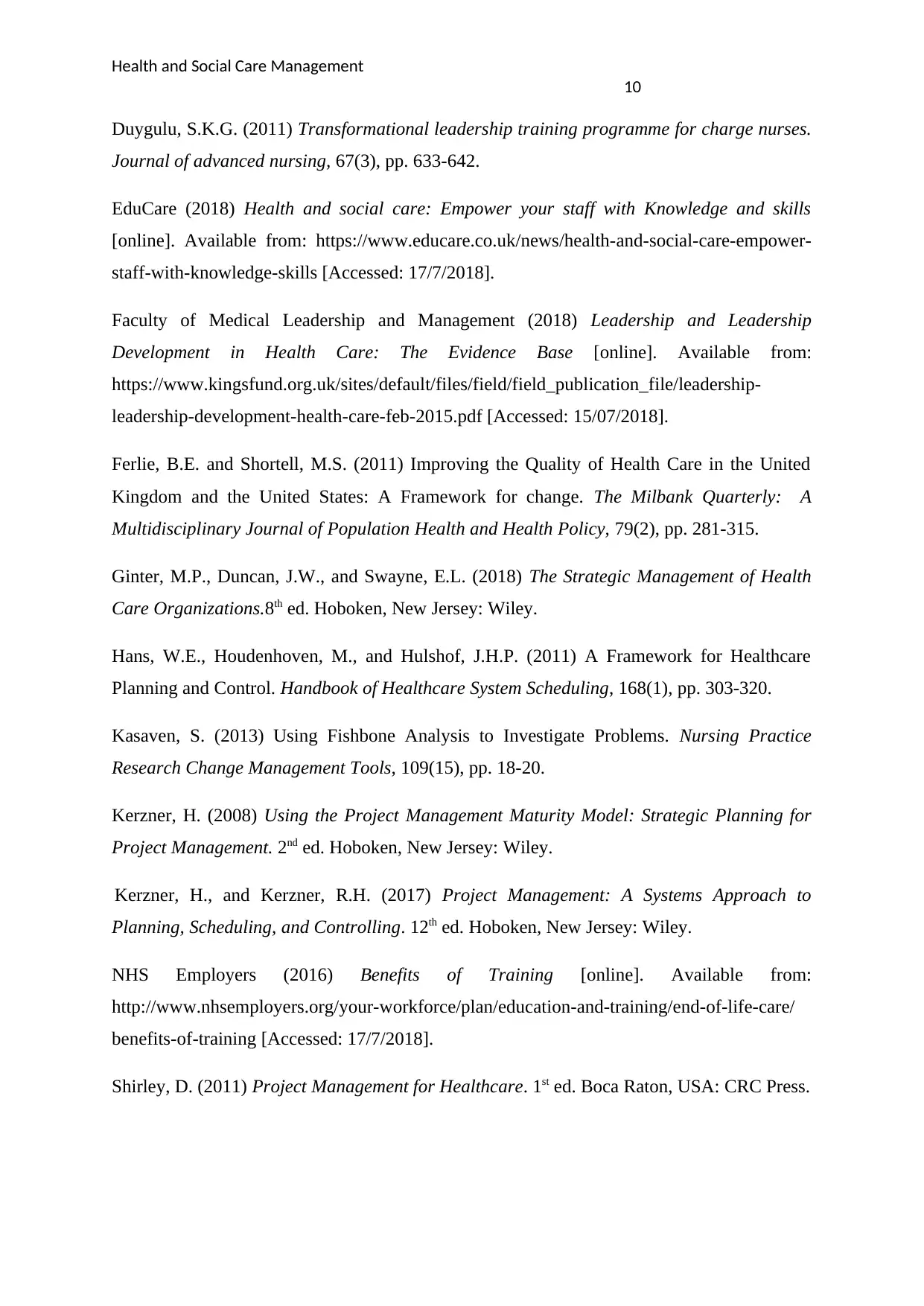
Health and Social Care Management
10
Duygulu, S.K.G. (2011) Transformational leadership training programme for charge nurses.
Journal of advanced nursing, 67(3), pp. 633-642.
EduCare (2018) Health and social care: Empower your staff with Knowledge and skills
[online]. Available from: https://www.educare.co.uk/news/health-and-social-care-empower-
staff-with-knowledge-skills [Accessed: 17/7/2018].
Faculty of Medical Leadership and Management (2018) Leadership and Leadership
Development in Health Care: The Evidence Base [online]. Available from:
https://www.kingsfund.org.uk/sites/default/files/field/field_publication_file/leadership-
leadership-development-health-care-feb-2015.pdf [Accessed: 15/07/2018].
Ferlie, B.E. and Shortell, M.S. (2011) Improving the Quality of Health Care in the United
Kingdom and the United States: A Framework for change. The Milbank Quarterly: A
Multidisciplinary Journal of Population Health and Health Policy, 79(2), pp. 281-315.
Ginter, M.P., Duncan, J.W., and Swayne, E.L. (2018) The Strategic Management of Health
Care Organizations.8th ed. Hoboken, New Jersey: Wiley.
Hans, W.E., Houdenhoven, M., and Hulshof, J.H.P. (2011) A Framework for Healthcare
Planning and Control. Handbook of Healthcare System Scheduling, 168(1), pp. 303-320.
Kasaven, S. (2013) Using Fishbone Analysis to Investigate Problems. Nursing Practice
Research Change Management Tools, 109(15), pp. 18-20.
Kerzner, H. (2008) Using the Project Management Maturity Model: Strategic Planning for
Project Management. 2nd ed. Hoboken, New Jersey: Wiley.
Kerzner, H., and Kerzner, R.H. (2017) Project Management: A Systems Approach to
Planning, Scheduling, and Controlling. 12th ed. Hoboken, New Jersey: Wiley.
NHS Employers (2016) Benefits of Training [online]. Available from:
http://www.nhsemployers.org/your-workforce/plan/education-and-training/end-of-life-care/
benefits-of-training [Accessed: 17/7/2018].
Shirley, D. (2011) Project Management for Healthcare. 1st ed. Boca Raton, USA: CRC Press.
10
Duygulu, S.K.G. (2011) Transformational leadership training programme for charge nurses.
Journal of advanced nursing, 67(3), pp. 633-642.
EduCare (2018) Health and social care: Empower your staff with Knowledge and skills
[online]. Available from: https://www.educare.co.uk/news/health-and-social-care-empower-
staff-with-knowledge-skills [Accessed: 17/7/2018].
Faculty of Medical Leadership and Management (2018) Leadership and Leadership
Development in Health Care: The Evidence Base [online]. Available from:
https://www.kingsfund.org.uk/sites/default/files/field/field_publication_file/leadership-
leadership-development-health-care-feb-2015.pdf [Accessed: 15/07/2018].
Ferlie, B.E. and Shortell, M.S. (2011) Improving the Quality of Health Care in the United
Kingdom and the United States: A Framework for change. The Milbank Quarterly: A
Multidisciplinary Journal of Population Health and Health Policy, 79(2), pp. 281-315.
Ginter, M.P., Duncan, J.W., and Swayne, E.L. (2018) The Strategic Management of Health
Care Organizations.8th ed. Hoboken, New Jersey: Wiley.
Hans, W.E., Houdenhoven, M., and Hulshof, J.H.P. (2011) A Framework for Healthcare
Planning and Control. Handbook of Healthcare System Scheduling, 168(1), pp. 303-320.
Kasaven, S. (2013) Using Fishbone Analysis to Investigate Problems. Nursing Practice
Research Change Management Tools, 109(15), pp. 18-20.
Kerzner, H. (2008) Using the Project Management Maturity Model: Strategic Planning for
Project Management. 2nd ed. Hoboken, New Jersey: Wiley.
Kerzner, H., and Kerzner, R.H. (2017) Project Management: A Systems Approach to
Planning, Scheduling, and Controlling. 12th ed. Hoboken, New Jersey: Wiley.
NHS Employers (2016) Benefits of Training [online]. Available from:
http://www.nhsemployers.org/your-workforce/plan/education-and-training/end-of-life-care/
benefits-of-training [Accessed: 17/7/2018].
Shirley, D. (2011) Project Management for Healthcare. 1st ed. Boca Raton, USA: CRC Press.
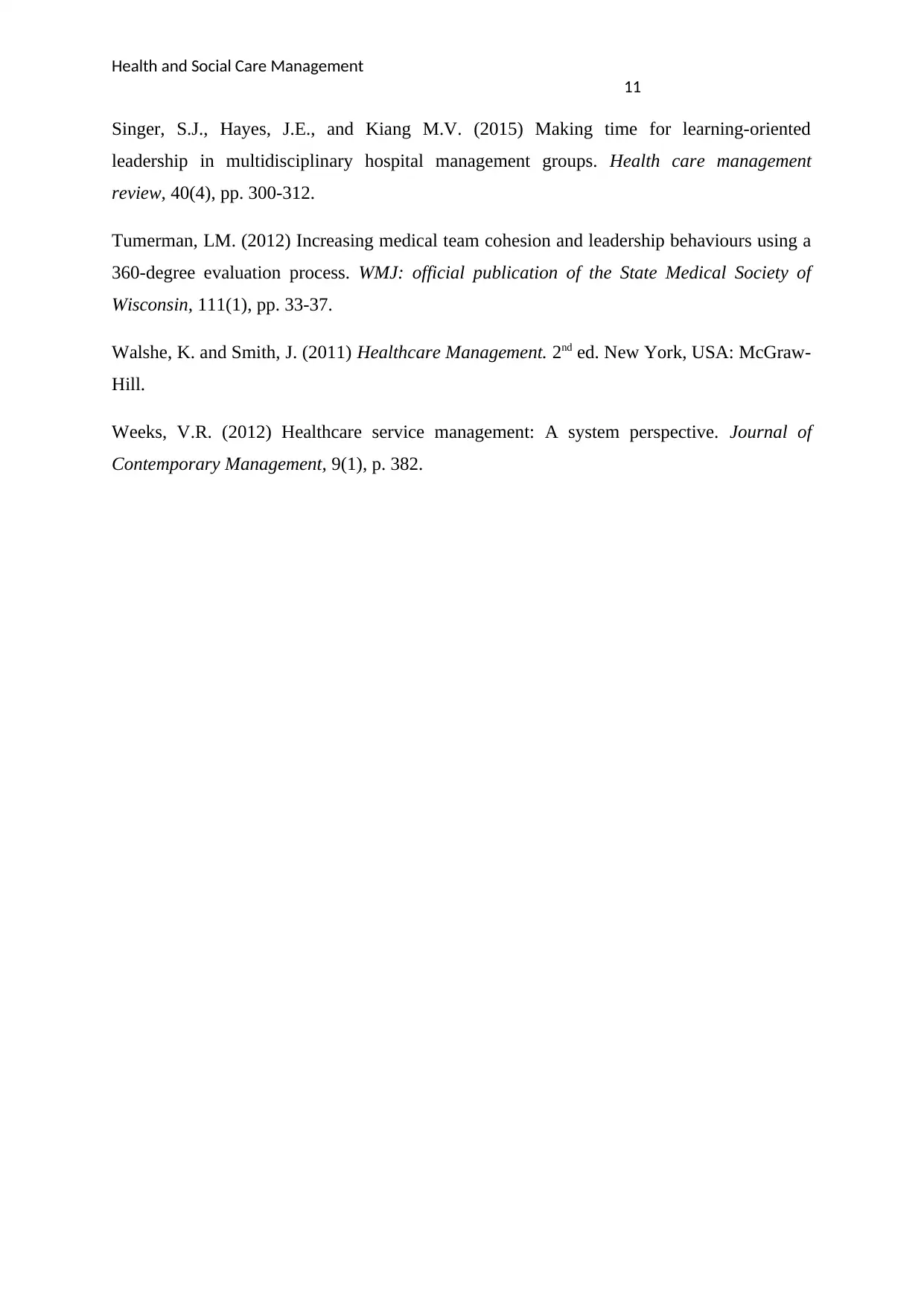
Health and Social Care Management
11
Singer, S.J., Hayes, J.E., and Kiang M.V. (2015) Making time for learning-oriented
leadership in multidisciplinary hospital management groups. Health care management
review, 40(4), pp. 300-312.
Tumerman, LM. (2012) Increasing medical team cohesion and leadership behaviours using a
360-degree evaluation process. WMJ: official publication of the State Medical Society of
Wisconsin, 111(1), pp. 33-37.
Walshe, K. and Smith, J. (2011) Healthcare Management. 2nd ed. New York, USA: McGraw-
Hill.
Weeks, V.R. (2012) Healthcare service management: A system perspective. Journal of
Contemporary Management, 9(1), p. 382.
11
Singer, S.J., Hayes, J.E., and Kiang M.V. (2015) Making time for learning-oriented
leadership in multidisciplinary hospital management groups. Health care management
review, 40(4), pp. 300-312.
Tumerman, LM. (2012) Increasing medical team cohesion and leadership behaviours using a
360-degree evaluation process. WMJ: official publication of the State Medical Society of
Wisconsin, 111(1), pp. 33-37.
Walshe, K. and Smith, J. (2011) Healthcare Management. 2nd ed. New York, USA: McGraw-
Hill.
Weeks, V.R. (2012) Healthcare service management: A system perspective. Journal of
Contemporary Management, 9(1), p. 382.
⊘ This is a preview!⊘
Do you want full access?
Subscribe today to unlock all pages.

Trusted by 1+ million students worldwide
1 out of 12
Related Documents
Your All-in-One AI-Powered Toolkit for Academic Success.
+13062052269
info@desklib.com
Available 24*7 on WhatsApp / Email
![[object Object]](/_next/static/media/star-bottom.7253800d.svg)
Unlock your academic potential
Copyright © 2020–2025 A2Z Services. All Rights Reserved. Developed and managed by ZUCOL.





